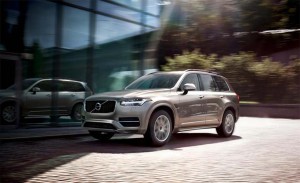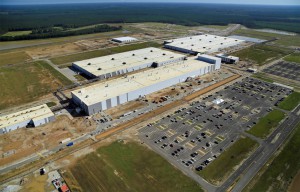
Volvo is enjoying strong sales in the U.S. with products like the XC90, which will now be built in Charleston, South Carolina, starting in 2021.
Volvo now plans to produce its most popular vehicle in the United States with the XC90 set to start rolling off the Swedish maker’s new Charleston, South Carolina assembly plant in 2021.
The announcement also confirms that Volvo will double the size of the facility, which was originally intended to produce the mid-range S60 sedan when it goes into operation next year. The expansion will bring the total cost of the Charleston complex to $1.1 billion, about $520 million more than was originally announced. And it will now employ nearly 4,000 hourly and salaried workers.
The expansion, which was first reported earlier this month by TheDetroitBureau.com, “underscores our commitment to the United States,” said Lex Kerssemakers, who served as CEO of Volvo Cars North America until Sept. 15. He is now heading European operations.
(Volvo set to double size of Charleston plant. Click Here for details.)
The South Carolina plant is one of three that have been added to Volvo’s global manufacturing footprint since the Swedish carmaker was purchased from Ford Motor Co. by China’s Zhejiang Geely Holding Group in 2010. The other two are in China.
They are proving critical to Volvo’s rapid growth, the automaker setting three consecutive annual sales records and on target for a fourth this year. Last year, it saw an increase of 6.2%, volume jumping to 534,332. It is targeting 800,000 by the end of the decade.
The XC90 – which was named North American Truck/Utility Vehicle of the Year in 2016 – has been critical to that growth, especially in the United States, Volvo’s second largest export market behind China. But demand for the ute has been so strong worldwide that Volvo has been struggling with supply shortages. As a result, the brand’s overall sales in the American market actually dipped 7% for the first eight months of 2017, though they increased 4.1% in August.
The U.S. is the single-largest market for the XC90, noted Kerssemakers, reflecting the dramatic shift from sedans and coupes to the SUVs, CUVs, vans and pickups that now account for nearly two-thirds of overall new vehicle sales.
(Click Here for more about new automotive jobs coming and leaving the U.S.)
The Charleston plant – which will grow to a capacity of 150,000 vehicles annually when the expansion is completed – will serve as the sole worldwide source for the S60 sedan. It will be one of at least two production sources for the next-generation XC90, and will service both the U.S. and other markets, Volvo officials said.
By the time the next version of the ute goes into production Volvo will have completed a dramatic shift in its powertrain strategy. The Swedish subsidiary of Geely has already abandoned the six and eight-cylinder engines that normally defined vehicles in the luxury segment. Instead, it has adopted an “all-four” strategy. That includes its most sporty T8 Twin Engine, a plug-in hybrid making 400 horsepower.
With all new models introduced in 2018 and beyond, Volvo announced in June, it will only use “electrified” powertrains. These include not only plug-ins like the T8 but all-electric models and those using more conventional hybrid drivetrains. The “vast majority” of its sales will be hybrids, Kerssemakers said during an interview with TheDetroitBureau.com last month.
The originally planned portion of the new Volvo plant will open just outside of Charleston late next year. It is scheduled to employ 2,000, with another 1,910 jobs to be added when the second phase goes into operation by 2021.
(Why are Volvo’s top executives swapping jobs? Click Here to find out.)
The factory joins an expanding automotive base that has sprung up in the Southern coastal state. That includes a BMW plant in Spartanburg that finished a $1 billion expansion last year and is now set to undergo another major expansion that will make it the largest automotive export facility in the U.S.

